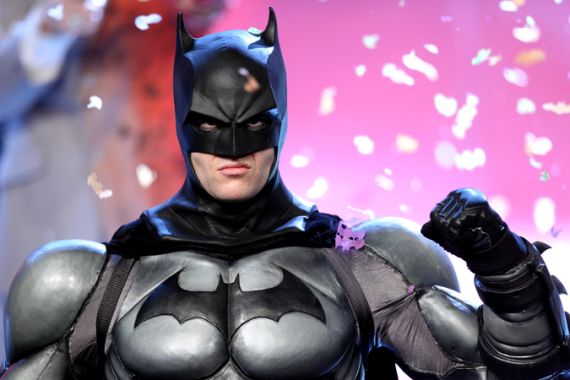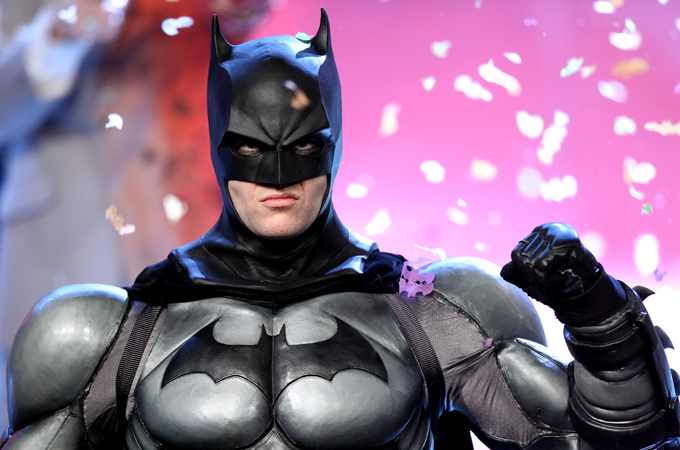Batman to the rescue
Batman has inspired the occupy movement to use elements of popular culture to project their need for rescue from the 1%.

 |
| Occupy protesters erected a ‘bat signal’ in New York that projected ‘99%’ instead of the familiar bat [GALLO/GETTY] |
New York, NY – We live in an age of Superbowls and Super Committees with millions hoping that some new superheroes will turn up to save us from a downward spiral of intractable problems.
A week ago, while New York’s Mayor was scolding Occupy Wall Street protesters for blocking sidewalks and streets, his Police Department was assisting a movie company that was making a new Batman film that screwed up traffic on a major highway for hours.
Hollywood movies bring big bucks into town, even if the people have to be inconvenienced, but now the Batman story has a new meaning.
We all know the narrative.
Bruce Wayne, a member in good standing of the one per cent, in the town of Gotham created a secret headquarters for a character called Batman, based in the family mansion, It was there that he launched a war on crime that soon had a young recruit at his side, Dick Grayson, originally known as, Robin the Wonder boy. His witty Butler helped the team pull off its death-defying missions.
This dynamic duo soon became the stuff of legends – thanks to an entertainment industry that promoted the story into a billion dollar empire driven, first, by the sale of comic books and then major Hollywood films.
The story resonated not only because of the thrilling stunts and specialised cars that helped them pull it off but because of a story line, an urban legend about men with special powers who could rescue their town from certain doom.
One recurring scene involved a special light with the sign of a bat that would be projected by the Police Commissioner onto buildings to summon Batman and Robin into action.
In the real world, New York created its own modern day Batman and Robin in the form of Mayor Michael Bloomberg, an ambitious billionaire who sallied forth in the company of his own Robin, Police Chief Ray Kelly, to save the City from itself.
The Batman story had been turned inside out.
Old fashioned villains like the evil Scarecrow that the original Batman fought soon disappeared from view to be replaced in the real world by a caste of white collar criminals who used their perches on Wall Street to accumulate vast wealth from fraud and leverage in a financial system operating without regulation or restraint.
The Joker was on us.
When a small group of rebels, began to challenge this system, the Mayor brought out the bats, now called truncheons, to sometimes brutally defend the banksters and their allies from the non-violent demands of a growing army of anger called Occupy Wall Street, They had tried to shut down Wall Street but thousands of riot police with barricades and batons assured they could only slow it down.
The American Bankers Association has reportedly now been pitched by a top-lobbying firm to launch a $845,000-media campaign to counter Occupy Wall Street.
Some wise guys on The Street, as it’s known, baited the protests with signs that read “Occupy a Job or a Desk”, apparently unaware of how difficult it is for young people to find jobs, partly through their own speculative gambling.
Hahaha!
On November 15th, New York’s Batman Bloomberg had shut down the Occupy Wall Street encampment in the middle of the night while banning the press. He rounded up as many troublemakers as he could, and now has his cops spying on the rest, even in churches.
To the surprise of many, this rag tag movement survived several mass arrests and denunciations from on high, has just celebrated its second month of daily protests with the press speculating about its future.
James Stewart, a Pulitzer prize winning columnist in the New York Times has been persuaded that this movement that Occupy Wall Street has potential and staying power, “it’s tempting to dismiss the movement as little more than a short-lived media phenomenon. The issues that spawned the movement – income inequality, money in politics and Wall Street’s influence – were being drowned out by debates over personal hygiene, noise and crime… But critics and supporters alike suggest that the influence of the movement could last decades, and that it might even evolve into a more potent force”.
When the movement marched on triumph on November 17, a day of global action, its numbers had swelled to 40,000 with union support. They crossed the hundred plus year old Brooklyn Bridge where 700 had been arrested a month earlier.
As they did, they looked up at a building owned by the Verizon phone company.
There they saw and cheered an unexpected surprise, a dramatic image, a new bat signal, no longer an demand for help from a philanthropic plutocrats but, now an appeal to the people, the 99 per cent, to get involved.
The website Portside reported: “One of the most impressive moments of yesterday’s Occupy Wall Street marches, was when someone projected a giant 99 per cent “bat signal” on the side of one of lower Manhattan’s skyscrapers as thousands of people swarmed across the nearby Brooklyn Bridge. New Yorkers know the Verizon Building, as the windowless, concrete eyesore that looms over the bridge and mars the downtown skyline, so seeing it used is such a way certainly got a lot of attention.
But who did it? And how were they able to project the stories-high words on the building just as the protesters made their way over the span? Boing Boing’s Xeni Jardin spoke to Mark Read, one of the Occupy Wall Street organiser who pulled together a team of friends and artists that arranged for the projection to happen.
Read says he got help from two video projection artists, Max Nova and JR Skola, who used a 12,000 lumen projector and programmed the software needed to properly program the message. He also found an apartment in a nearby housing project from where they safely angle the projection on to the building. He says he offered to rent the apartment from a single mother of three, but when she found out what they wanted to use it for – and saw what happened during the eviction of Zuccotti Park – she refused to take their money.”
Talk about modern urban legends. This bat signal is now featured on YouTube, with music by Hollywood’s Hans Zimmer. The song: “To Know My Enemy.”
In its own eyes, the movement, led by young people deeply immersed in popular culture, has become a Batman out to save America from crime and corruption. And it’s doing so in the name of the majority, the 99 per cent.
News Dissector Danny Schechter reports on the movement on his blog at newsdissector.com. He made the film Plunder about the financial crisis as a crime story. Comments to dissector@mediachannel.org.
Follow Danny Schecter on Twitter @DISSECTOREVENTS
The views expressed in this article are the author’s own and do not necessarily reflect Al Jazeera’s editorial policy.
